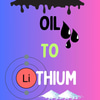The Rise of Lithium in the Renewable Era
The global energy landscape is undergoing a significant transformation, shifting from traditional fossil fuels to renewable energy sources. A pivotal aspect of this transition is the move from oil to lithium, reflecting the broader change from conventional energy to sustainable alternatives.
1/15/20252 min read


The global energy landscape is undergoing a significant transformation, shifting from traditional fossil fuels to renewable energy sources. A pivotal aspect of this transition is the move from oil to lithium, reflecting the broader change from conventional energy to sustainable alternatives.
The Historical Significance of Oil
For over a century, oil has been the backbone of global industrialization. It powered factories, fueled transportation, and played a central role in shaping modern economies. Regions rich in oil reserves, such as the Middle East and parts of the United States, experienced rapid economic growth and geopolitical influence. However, the environmental consequences of oil extraction and consumption, including greenhouse gas emissions and ecological degradation, have become increasingly apparent.
The Rise of Lithium in the Renewable Era
Lithium, a lightweight metal, has emerged as a critical component in the renewable energy sector, particularly in the production of lithium-ion batteries. These batteries are essential for electric vehicles (EVs), portable electronics, and grid storage solutions, enabling the efficient use of renewable energy sources like solar and wind power. The demand for lithium has surged, with projections indicating a continued upward trend as the world seeks cleaner energy alternatives.
Innovative Extraction Methods: Lithium from Oilfield Brines
An intriguing development in the energy sector is the extraction of lithium from oilfield brines. In regions like the Smackover Formation in southern Arkansas, companies are exploring the potential of extracting lithium from underground brine reservoirs, historically associated with oil production. This method offers a dual benefit: repurposing existing oil extraction infrastructure and reducing the environmental footprint compared to traditional lithium mining practices. Companies like ExxonMobil have initiated projects to tap into these resources, signaling a strategic shift towards sustainable energy solutions.
Environmental Considerations and Technological Advancements
While lithium extraction presents opportunities, it also poses environmental challenges, such as water usage and potential contamination. To address these concerns, advancements in direct lithium extraction (DLE) technologies are being developed. For instance, researchers at Oak Ridge National Laboratory have innovated more efficient methods to extract lithium from mining sites and oil fields, aiming to support a circular economy and minimize environmental impacts.
The Road Ahead: Embracing a Sustainable Future
The transition from oil to lithium epitomizes the broader shift towards sustainable energy. It underscores the importance of technological innovation, environmental stewardship, and strategic adaptation in meeting global energy demands. As industries and governments collaborate to harness the potential of lithium and other renewable resources, the vision of a greener, more sustainable future becomes increasingly attainable.
In conclusion, the journey from oil to lithium is not just a change in energy sources but a transformative pathway towards sustainability. By embracing innovative extraction methods, addressing environmental challenges, and investing in renewable technologies, we can ensure a resilient and eco-friendly energy landscape for generations to come.




contact@oiltolithium.com
